Hot-dip galvanized covering
Hot-dip galvanized covering, is one of the most common galvanization method for metal components in LINKRAN installation and support systems. In this type of galvanization, the metal part will be immersed in a tank full of molten Zinc. Then the metal part removes from Zinc tank and the Zinc layer reacts with oxygen and carbon and becomes a corrosion-resistant and rust-resistant covering. Moreover, a chemical reaction occurs between the steel and the molten Zinc after hot-dip galvanization, and, several composite layers of iron and zinc are formed by developing metallic bonds that protect the base metal against corrosion and wearing (Fig.1). In this method, galvanized layer thickness is about 100 to 130 micro
The characteristics of galvanized Zinc covering with hot immersion are preferable compared to continuous hot electroplating and galvanizing, because hot-dip galvanized coating is thicker and therefore has a longer service life. It is also more heat-resistant and more abrasion resistant. The appearance of Zinc covering in the galvanizing method is warm, matte, opaque and gray, and it does not have a uniform and smooth surface
Hot-dip galvanized covering of LINKRAN’s metal parts
The steel which is going to be covered must be clean and be free of oil, dust, mill scale and rust. The process of surface preparation of LINKRAN’s metal parts usually includes degreasing, acid pickling and fluxing. Acid pickling is used for removing mill dust and rust and fluxing is used to develop a protective surface to restrain steel oxidation. According to the way of fluxing, process of hot-dip galvanization performs in two ways of dry and wet galvanizing

Dry coating in hot-dip galvanization
In dry galvanizing, the LINKRAN metal parts are placed in the solution of Ammonia Chloride (Solution of Zinc Ammonium Chloride) after the preparation stage and after being soaked in the dryer, and then placed in the melting tank of zinc
Wet covering in cold galvanization
In wet galvanization, a mixture of Zinc Ammonia Chloride is sprayed on the melted surface and the parts enter to the melting furnace directly after the preparation process and at the same time as they are impregnated with flux (Fig. 2). All steps of the process and the specification of hot-dip galvanized Zinc for covering metal and steel products is done in accordance with the ASTM International Standard
Instruction
In hot-dip galvanization, small metal parts can be varying from bolt and nuts to very large structural parts. As far as these materials are immersed in the molten Zinc, so Zinc can penetrate into cracks, threads, and areas that are difficult to access
In order to remove excess Zinc and achieve a smoother coverage, small parts are centrifuged in a special device after leaving the galvanized tank. If the parts are too long or too large for being centrifuged, the excess Zinc can be cleaned by brushing the surface while it is still hot
Over tapped
The most important point that should be considered in nut and bolts hot-dip galvanization is that the nut’s thread must be over tapped so that the Zinc thickness compensated. The applied sheets in all profiles of LINKRAN support and installation systems are produced with continuous hot-dip galvanized method (Fig. 3). In this process, Zinc thickness can be controlled by air blowing. This method is divided into two types: Continues and non-continuous immersion. In non-continues method, the cut sheets are placed in the melting tank, but in continuous method, continuous coils are covered in a continuous line

Write a Comment